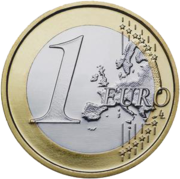
Back قطعة 1 يورو Arabic 1 euro Czech 1 euro Danish 1-Euro-Münze German Κέρμα 1 ευρώ Greek Moneda de un euro Spanish 1-eurone münt Estonian سکه ۱ یورویی Persian Pièce de 1 euro French Piéce de 1 erô FRP
| Value | 1 euro |
|---|---|
| Mass | 7.5 g |
| Diameter | 23.25 mm |
| Thickness | 2.33 mm |
| Edge | Alternating segments, three smooth, three finely ribbed |
| Composition | Outer segment: nickel brass. Inner segment: three layers: copper-nickel, nickel and copper-nickel. |
| Years of minting | 2002–present (from 1999 only for France, Finland, Spain, Belgium and the Netherlands; from 2001 only for Monaco) |
| Obverse | |
| Design | Numerous variations, see below. |
| Designer | Various |
| Design date | Various |
| Reverse | |
 | |
| Design | Map of Europe with the denomination shown in Latin characters |
| Designer | Luc Luycx |
| Design date | 2007 |
 | |
| Design | Map of the 15 EU countries of 1999 with the denomination shown in Latin characters |
| Designer | Luc Luycx |
| Design date | 1999 |
| Design discontinued | 2007 (still in circulation as of 2024[update]) |
The 1 euro coin (€1) is a euro coin with a value of one euro. It is made of two alloys: the inner part of cupronickel, the outer part of nickel brass. All coins have a common reverse side and country-specific national sides. The coin has been used since 2002, with the present common side design dating from 2007.
As of July 2019, there were approximately 7.5 billion one-euro coins in circulation, constituting 25.3% of all circulated euro coins by value and 5.6% by quantity.[2]
- ^ Institutions and the members of the Eurozone
- ^ "2.1 Quantities - 2.Euro coins - Banknotes and coins statistics - ECB/Eurosystem policy - Reports - ECB Statistical Data Warehouse". sdw.ecb.europa.eu. Retrieved 2019-08-26.